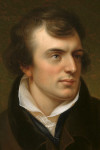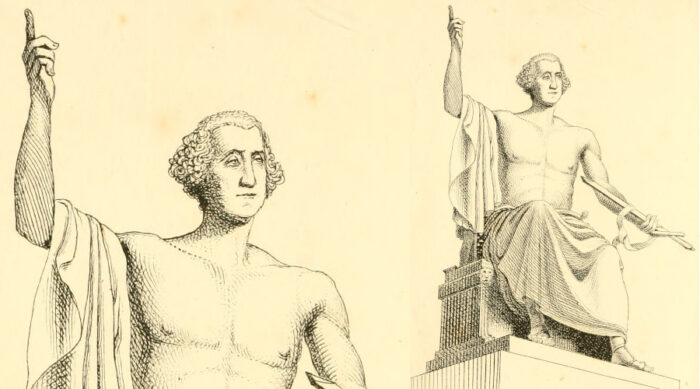
I have previously alluded a few times to the statue of George Washington by Horatio Greenough (pictured on the left) which is housed currently in the Smithsonian American History Museum. Over the next weeks, I want to look at its peripatetic existence before it finally came to rest.
On the 100th anniversary of the birth of George Washington, the House of Representatives adopted a resolution stating that the President had authorized to employ Greenough to create “in marble, a full length pedestrian statue of Washington.” It was to use as a model the famous bust of Jean-Antoine Houdon in Richmond, a statue that was generally considered to be the one most accurately showing the first President’s face. The rest was “left to the judgment of the Artist.”
Greenough went off to his studio in Florence, Italy, and began his work. The statue was completed in early 1841, and the Navy was given the task of transporting it to Washington. As it turned out, no current Navy ship was capable of doing this, so a Packet-ship named “Sea” was pressed into service. Even this ship required some work to accept the statue, but by August 3, 1841, the ship was safely docked at the Navy Yard, with the statue on board.
A few days later, the Alexandria Gazette published a lengthy review of the statue, taken (most likely) from the article “Modern Art and Artists in Italy” by Giberna, a pseudonym for Lady Rosina Wheeler Bulwer-Lytton ––estranged wife of Edward Bulwer-Lytton–– and published in the May 8, 1841 issue of Court Journal.
But the manner in which Greenough has executed his almost impossible task is only another proof that genius can infuse a magic into the commonest and most common place things, just as a man was a mass of inanimate clay “of the earth earthy,” till God breathed immortality into him, and so formed him after his own image. Nothing can be more human, and at the same time more godlike, than this colossal statue of Washington. It is a sort of domestic Jupiter – the sublime repose and simplicity of the whole figure, united, as it is, with exceeding energy of expression, is perfectly classical, without the slightest abstract imitation, for the artist seems to have embodied Seneca’s admirable advice as to style – similem esse te volo, quomodo filium, non quo modo imaginem, as there is no mistaking the pure lineage of this statue.
The panegyric went on in this vein for several more, equally turgid, sentences.

As it turned out, Bulwer-Lytton’s opinion did not find much resonance once the statue had been seen by the public. In the end, Edward Everett (now best-known for his two-hour speech just before Lincoln’s on the occasion of the dedication of the Gettysburg National Cemetery in November, 1863) was called upon to counter two of the most-often stated criticisms. He first argued that having Washington seated while handing over his sword meant that this was not intended to be an exact representation of the General resigning his commission, then stated that Washington’s bare upper torso was also appropriate:
This drapery, in the statue of Washington, gives the artist the opportunity of displaying the nervous arm, the broad shoulders, the full throat, the arching breast, and swelling muscles of an heroic figure, in all their beautiful and manly proportions and symmetry.
Unsurprisingly, this did little to quiet the critics.
In future installments, we will see what happened to the statue over the next years.
